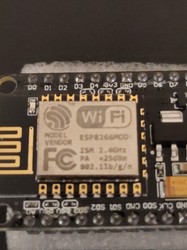Originally the idea was that you would have a domain and then have a host under that domain for each service (e.g. mail.example.net, ftp.example.net, www.example.net,…). Of course eventually the web was used by a lot more people this directly than any other service so the main domain was also configured to point at the web server and then people added a redirect either in one direction (add www.) or the other (remove www.) on the first request.
The final piece is that often each of those services would be on a different computer entirely, each with a different public IP address. Otherwise the port is sufficient to sperate most services on a common domain.
There was a good long while where IP addresses were still unutilized enough that there was no reason to even try being conservative.
Originally there also wasn’t any name-based virtual hosting, especially in SSL/TLS-based services like HTTPS so you needed one IP per name if you wanted to host multiple websites.
And part of the disappearance of www. now is probably that strange decision by Chrome to hide it.
Chromes decision actually makes a lot of sense, from a security perspective. When we model how people read URLs, they tend to be “lazy” and accept two URLs as equal if they’re similar enough. Removing or taking focus away from less critical parts makes users focus more on the part that matters and helps reduce phishing. It’s easier to miss problems with https://www.bankotamerica.com/login_new/existing/login_portal.asp?etc=etc&etc=etc than it is with bankotamerica, with the com in a subdued grey and the path and subdomain hidden until you click in the address bar.
It’s the same reason why they ended up moving away from the lock icon. Certs are easy to get now, and every piece that matches makes it more likely for a user to skip a warning sign.
Well also at one point www.domain.com may have actually been a single physical server. That hasn’t been true for sites of any size in a long time.
Yes that’s what the article said.
Yeah, but in many, many more words than necessary to be honest.
Some websites still require you to type www. explicitly.
For example, my university… Try https://tu-darmstadt.de/ and then try https://www.tu-darmstadt.de/
I find that annoying because I’m lazy 😂
That’s a 5-minute workaround in the server config. Hate it when idiots skip that. I’m no dev, but I’ve done it many times.
I am a dev, and it makes me think whoever is in charge is extremely incompetent.
Or old school. Web used to be just one of the provided services. mail.tu-darmstad.de, ftp.tu-darmstad.de, www.tu-darmstad.de, not prioritizing any of them
If you’re in charge of running a live environment and running it like it’s still the 90s, then you’re incompetent.
Try going to https://www.lemmy.world/
Now I’m angry. 🙄
www is just a host name, totally arbitrary.
I prefer it, so I just redirect HTTP requests my root domain to the www version. I think it makes a ton of sense, since I www is merely one of the many services I host at my domain.
When I was in school it was just when all this was starting and people were starting to get used to the internet. There are a lot of websites they thought were inappropriate for children to look at (mostly they were harmless). Anyway if you didn’t enter
www.in front of the web address, it bypassed all of the site block filters.When I was in school it was just when all this was starting and people were starting to get used to the internet. There are a lot of websites they thought were inappropriate for children to look at (mostly they were harmless). Anyway if you didn’t enter
www.in front of the web address, it bypassed all of the site block filters.
Its a subdomain you have to make sure you point to your main domain at your domain registar
There’s another, more DNS-related, reason why it was usually preferred to have something before the domain part. It’s possible to alias a subdomain to another subdomain, but not so with the root of a domain, which must point directly at a single IP address.
If your IP addresses are more subject to change than your hostnames, or your site was hosted on a third party service, then it made sense to point www at a particular hostname rather than its address. e.g. you might point www.your-domain-here.biz at a-hostname.the-hosting-provider.tld. That’s not possible with a root domain. IP address or nothing.
Similarly, it’s possible to point a subdomain at multiple IP addresses (or multiple hostnames) at the same time, which was a cheap way to do load balancing. i.e. For a site a user hadn’t visited before, they’d be basically told one of the listed IP addresses at random, and then their local DNS cache would return that one IP address until it expired, generally giving enough time for the visitor to do what they wanted. Slap 8 different IPs in the www subdomain and you’d split your visitors across 8 different servers.
Root domain has no such capability.
Technically it would be possible to do all of that one level higher in DNS where your domain itself is the subdomain, but good luck getting a domain registry to do that for you.
I haven’t done DNS in over a decade at this point, so things may have changed in the intervening years, but this was all definitely a thing once upon a time.
Any old slashdotters remember tcwww, The Cursed www? Just me?
Also tangentially related: one of Tim Berners-Lee’s regrets is the two forward slashes between the protocol scheme and the domain name
Also I love that the older BBC articles are frozen in time like this
Plus domains should’ve gone left to right in terms of root, tld, domain, subdomain, etc., instead of right to left.
It’s easy to redirect a domain such as “archive.org” to “www.archive.org” and vice versa. Just a line in your webserver config. Or just serve it directly from the former.
Ideally you want to do one or the other unless you really like the redirect loop error page in your browser.
I’m a rebel. And that’s my security plan.
Security by
obscurityinfinite redirection
It annoys me how www. is pronounced in english. Really, double-u double-u double-u dot example dot com?
How else would you say it?
“Wwwwuuuuhh dot Google dot com”?
Edit: or I guess, “world wide web” would make more sense?
“web” would have sounded nice and clear, we also didn’t name FTP the World Wide File Transfer Protocol (WWFTP).
In other languages, German for instance, it’s pronounced kinda like “weh” or like the letter V in English. It’s easier to say that way. Back in the day I sometimes said “triple double u” to not have to say it the actual, complicated way 😅
i like how saying “word wide web” is faster than saying “www”
Same thing in French. Doublevédoublevédoublevé. So. long.
It never got over you
The article seems to not understand the difference between a subdomain and a name.
No poInt in reading.
There’s no WWW anymore. There’s content and there are Internet platforms. You should consume content and and hold your breath for what platforms have for you, as part of a crowd many-many times bigger than the one at Mecca. Not G-d forbid host websites and visit them, read what others have to say, see culture and history of something real.
Guys I don’t think they read the article
They did. They are not obligated by any rule to limit their associations like some dumb apes do









